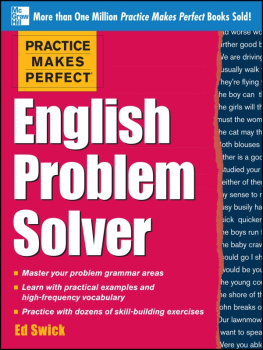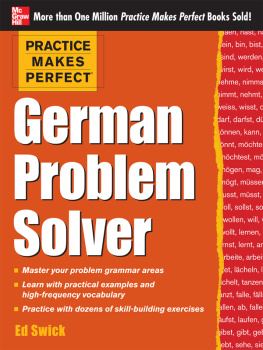PRACTICE MAKES PERFECT German Sentence Builder
Ed Swick


Copyright 2009 by The McGraw-Hill Companies, Inc. All rights reserved. Except as permitted under the United States Copyright Act of 1976, no part of this publication may be reproduced or distributed in any form or by any means, or stored in a database or retrieval system, without the prior written permission of the publisher.
ISBN: 978-0-07-159963-4
MHID: 0-07-159963-0
The material in this eBook also appears in the print version of this title: ISBN 978-0-07-159962-7, MHID: 0-07-159962-2.
All trademarks are trademarks of their respective owners. Rather than put a trademark symbol after every occurrence of a trademarked name, we use names in an editorial fashion only, and to the benefit of the trademark owner, with no intention of infringement of the trademark. Where such designations appear in this book, they have been printed with initial caps.
McGraw-Hill eBooks are available at special quantity discounts to use as premiums and sales promotions, or for use in corporate training programs. To contact a representative please e-mail us at bulksales@mcgraw-hill.com.
TERMS OF USE
This is a copyrighted work and The McGraw-Hill Companies, Inc. (McGraw-Hill) and its licensors reserve all rights in and to the work. Use of this work is subject to these terms. Except as permitted under the Copyright Act of 1976 and the right to store and retrieve one copy of the work, you may not decompile, disassemble, reverse engineer, reproduce, modify, create derivative works based upon, transmit, distribute, disseminate, sell, publish or sublicense the work or any part of it without McGraw-Hills prior consent. You may use the work for your own noncommercial and personal use; any other use of the work is strictly prohibited. Your right to use the work may be terminated if you fail to comply with these terms.
THE WORK IS PROVIDED AS IS. McGRAW-HILL AND ITS LICENSORS MAKE NO GUARANTEES OR WARRANTIES AS TO THE ACCURACY, ADEQUACY OR COMPLETENESS OF OR RESULTS TO BE OBTAINED FROM USING THE WORK, INCLUDING ANY INFORMATION THAT CAN BE ACCESSED THROUGH THE WORK VIA HYPERLINK OR OTHERWISE, AND EXPRESSLY DISCLAIM ANY WARRANTY, EXPRESS OR IMPLIED, INCLUDING BUT NOT LIMITED TO IMPLIED WARRANTIES OF MERCHANTABILITY OR FITNESS FOR A PARTICULAR PURPOSE. McGraw-Hill and its licensors do not warrant or guarantee that the functions contained in the work will meet your requirements or that its operation will be uninterrupted or error free. Neither McGraw-Hill nor its licensors shall be liable to you or anyone else for any inaccuracy, error or omission, regardless of cause, in the work or for any damages resulting therefrom. McGraw-Hill has no responsibility for the content of any information accessed through the work. Under no circumstances shall McGraw-Hill and/or its licensors be liable for any indirect, incidental, special, punitive, consequential or similar damages that result from the use of or inability to use the work, even if any of them has been advised of the possibility of such damages. This limitation of liability shall apply to any claim or cause whatsoever whether such claim or cause arises in contract, tort or otherwise.
To Riane, AJ, Jalyn, Tori, and Riley, my terrific grandkids.
Contents
Acknowledgments
I wish to extend my gratitude to Stefan Feyen for all his help and suggestions.
Introduction
Writing skills are usually the most difficult skills to acquire in a language. This is particularly true in a foreign language. The goal of this book is to guide you through the various types of structures in the German language and to illustrate how those structures combine to make sentences.
Naturally, in order to acquire writing skills you have to write. Therefore, you will be provided with an abundance of writing exercises. Some will require a small variation in a given sentence. Others will provide you with a series of words that you form into an appropriate sentence. And you will have plenty of opportunity for coming up with original sentences of your own. This development of your German sentence writing moves gradually and with careful explanation from the least complex activity to the most complex.

In addition to the illustrations of how structures combine to form sentences, and the practice exercises, an answer key is provided at the end of the book. It includes not only the correct answers for the exercises but also sample sentences for you to use to compare to your original sentences.
Good sentence writing is not an impossible task. But it requires analysis and practice and a willingness to apply concepts and rules consistently. Let this book guide you, and you will discover a new confidence as you write more successfully in German.
Viel Glck!
1 Declarative sentences and word order
Declarative sentences in both English and German consist of a subject and a predicate. In German, the subject is in the nominative case, and the verb in the predicate is conjugated appropriately for the subject and in a specific tense:
subject + verb + predicate
Karl + singt + gut.
Karl sings well.
In the example sentence above, the subject is Karl and the verb singt is conjugated in the present tense for the third person singular subject. This basic structure is used in great abundance in the language and can be modified in a variety of ways. Nonetheless, its simple formula is subject plus predicate. If one of those elements is missing, you dont have a sentence.
Lets look at a series of sentences composed in this way. Take note of the subjects, the variety of verb types in the predicate, and the various tenses that can be used in declarative sentences. Many sentences are composed of a present perfect tense verb and the auxiliary haben:

Many are composed of a present perfect tense verb and the auxiliary sein:

Many appear in the future tense with the auxiliary werden:

Others can be a combination of a modal auxiliary and an infinitive:

And still others can be written in the passive voice:

In other words, a declarative sentence can take many forms.













